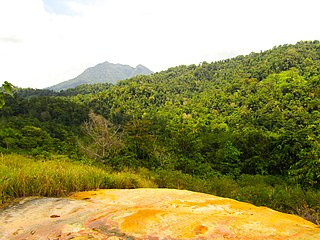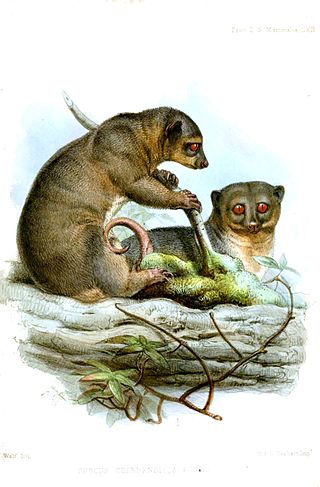The Sulawesi woodcock also known as Celebes woodcock, is a medium-sized wader. It is larger and darker than Eurasian woodcock but with small reddish spots.

The North Sulawesi babirusa is a pig-like animal native to Sulawesi and some nearby islands in Indonesia. It has two pairs of large tusks composed of enlarged canine teeth. The upper canines penetrate the top of the snout, curving back toward the forehead. The North Sulawesi babirusa is threatened from hunting and deforestation.
Sommer's Sulawesi rat is a species of rodent in the family Muridae from Sulawesi. It is the only species in the monotypic genus Sommeromys and was described by Musser & Durden in 2002.

Ariadne merione, the common castor, is an orange butterfly with brown lines whose larvae feed almost exclusively on castor. It is similar in appearance to Ariadne ariadne, the angled castor.

Jerdon's baza is a moderate sized brown hawk with a thin white-tipped black crest usually held erect. It is found in South-east Asia. It inhabits foothills in the terai and is rarer in evergreen forests and tea estates.

The Celebes warty pig, also called Sulawesi warty pig or Sulawesi pig, is a species in the pig genus (Sus) that lives on Sulawesi in Indonesia. It survives in most habitats and can live in altitudes of up to 2,500 m (8,000 ft). It has been domesticated and introduced to a number of other islands in Indonesia.

Bogani Nani Wartabone National Park is a 2,871 km2 (1,108 mi2) national park on Minahassa Peninsula on Sulawesi island, Indonesia. Formerly known as Dumoga Bone National Park, it was established in 1991 and was renamed in honour of Nani Wartabone, a local resistance fighter who drove the Japanese from Gorontalo during World War II. The park has been identified by Wildlife Conservation Society as the single most important site for the conservation of Sulawesi wildlife and is home to many species endemic to Sulawesi.
The Sulawesi yellow bat is a species of vesper bat. It is found only in Indonesia.

The Sulawesi dwarf cuscus is a species of arboreal marsupial in the family Phalangeridae that is endemic to Sulawesi and nearby islands in Indonesia. It inhabits tropical moist lowland forest and is nocturnal, folivorous and usually found in pairs. S. celebensis is threatened by hunting and deforestation.

The Sulawesi rousette or Sulawesi fruit bat is a species of megabat in the family Pteropodidae endemic to Sulawesi, an island in Indonesia. It is presently the only member of the genus Pilonycteris.
The Timor warty pig is a subspecies of Sus celebensis, or Celebes warty pig. Though described as a separate species, it is a feral form of the Celebes warty pig found in the Lesser Sunda Islands.
Acanthotetilla celebensis is a species of sea sponge belonging to the family Tetillidae. It is only known from a single specimen collected at a depth of 14 m off Bunaken Island, north Sulawesi, Indonesia.

Troides oblongomaculatus, the oblong-spotted birdwing, is a birdwing butterfly found in Indonesia and New Guinea.

Elephas celebensis, the Sulawesi dwarf elephant, is an extinct species of elephant.
Babyrousa bolabatuensis, the Bola Batu babirusa, is a species of babirusa from the Indonesian island of Sulawesi. It was first described in 1950 as a subspecies of Babyrousa babyrussa, then the only recognized species of babirusa, and raised to species rank by Colin Groves and Erik Meijaard in 2002. At present the Bola Batu babirusa is only known for certain from subfossil remains from the southern arm of Sulawesi. Based on a single skull from central Sulawesi it has been suggested that babirusas from this part of Sulawesi represent an extant population of the Bola Batu babirusa, and this was followed in the third edition of Mammal Species of the World. However, the most recent major review also found similarities between the central Sulawesi specimen and the Togian babirusa, leading them to conclude that it represents an undescribed taxon and that the taxonomic position of central Sulawesi babirusas only can be determined through additional specimens. Subfossil remains from the south-western arm of Sulawesi, where now likely extinct, have been classified as Bola Batu babirusas, but these were considered unclassifiable in 2002, as were extant populations from the eastern arm of Sulawesi and Buton due to the lack of specimens. Due to these uncertainties, the IUCN Red List provisionally synonymized B. bolabatuensis under the northern Sulawesi species, B. celebensis, pending clarification of the taxonomy of Sulawesi babirusas.

The Sulawesi harpy fruit bat is a species of megabat in the family Pteropodidae. It is endemic to Indonesia where it is found in Sulawesi and in Soloi on Buton island.

Ariadne is a genus of nymphalid butterflies, commonly called castors, found from Sub-Saharan Africa to South-East Asia. It was erected by Thomas Horsfield in 1829. The genus was named after Ariadne the daughter of Minos, king of Crete.
Chaerilus celebensis also known as the Asian bush scorpion or speckled bush scorpion is a species of scorpion from the family Chaerilidae. It was described in 1894 by Reginald Innes Pocock, using material from Luwu on the island of Sulawesi (Celebes) in Indonesia. Although it has been reported from a number of locations in Southeast Asia, the only reliable records are from Luwu. Specimens are stocky and barely exceed 1.5 inches (38 mm) in length. They rarely sting and their venom is of little or no medical significance. They live in tropical forests, but remain in the soil and mulch, graze on low vegetation and insects and are not capable of climbing vertical surfaces.

Ariadne merionoides, the Holland's castor, is a butterfly in the family Nymphalidae. It is found in Sulawesi.












